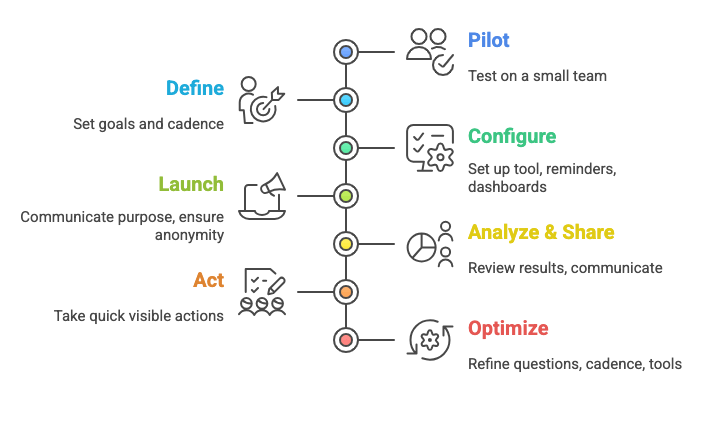Pulse surveys are quick, focused check‑ins sent to employees regularly, typically weekly or monthly, to gather timely insights into their experiences and sentiments.
Unlike lengthy annual questionnaires, pulses deliver agile feedback that HR teams can act on swiftly. When integrated with HR technology, such as automated survey tools, real‑time analytics dashboards, and AI‑driven sentiment analysis, pulse surveys become powerful engines for engagement, well‑being, and trust across an organization.
In this article, we’ll walk through why these surveys matter, how to set clear objectives and pick the right frequency, best practices for designing effective questions, and how to deploy surveys using modern HR tech.
We’ll also explore practical strategies for boosting participation, interpreting results smartly, and transforming feedback into meaningful action. By the end, you’ll have a structured, professional guide to implementing pulse surveys that truly resonate and deliver impact.
Key Takeaways
- Pulse surveys are short and frequent, typically 3–15 questions sent weekly or monthly to track employee sentiment in real time.
- They outperform annual surveys in participation and responsiveness, with engagement rates often reaching 75–90%.
- Modern HR tech tools like Rippling, Lattice, and Qualtrics automate delivery, track trends, and power sentiment analysis.
- Effective questions are clear, concise, and anonymous, combining quantitative and open-ended prompts for deeper insights.
- Follow-up matters, sharing results and taking visible action builds trust and encourages honest future feedback.
- Advanced tactics like AI-driven surveys and predictive analytics are shaping the future of continuous employee listening.
What Are Pulse Surveys? Definition, Benefits, and HR Use Cases
A pulse survey is a short, targeted questionnaire typically just 3–15 questions, designed to check in with employees on specific topics such as engagement, well-being, workload, or organizational culture .
They stand out by offering:
- Regular rhythm: Delivered weekly, bi-weekly, or monthly.
- Concise format: Easily completed in just a few minutes.
- Focused scope: Tracking changes over time in one or two key areas .
Unlike traditional annual surveys, pulses are:
- Frequent and focused, offering near-immediate visibility into workforce trends,
- Short and accessible, typically 5–15 questions tailored to a current topic
- More engaging, with average response rates around 85%, far higher than standard annual surveys (~30–40%).
HR tech integration enables seamless distribution, reporting, and analytics, transforming pulse survey programs from administrative tasks into strategic initiatives.
Why Pulse Surveys Shine in 2025?
Pulse surveys are thriving this year because they deliver instant, actionable insights, alerting HR teams to concerns like stress or engagement dips before they escalate.
Their brevity drives participation, participation rates often surpass 80%, making the feedback both representative and reliable compared to traditional, longer surveys.
1. Real‑Time, Actionable Intelligence
Pulse surveys enable HR teams to receive continuous, live feedback highlighting spikes in workload, remote work hurdles, or morale dips, so they can intervene promptly rather than waiting for annual snapshots.
2. High Adoption Rates
By delivering short, targeted surveys directly in tools like Rippling or email, organizations achieve participation rates as high as 100%, ensuring data is far more representative and reliable than traditional long-form surveys.
3. Build Trust And Engagement
Transparent communication, sharing pulse results, and clear follow-up actions signal to employees that feedback matters, reinforcing trust and boosting morale by showing leadership truly listens and responds.
4. Data‑Driven People Management
Integrating pulse survey insights with HR analytics platforms enables predictive modeling, such as early detection of burnout or turnover risk, making workforce decisions more proactive and data-grounded.
Comparison Table: Pulse Surveys vs Annual Surveys
| Feature | Pulse Surveys | Annual Surveys |
|---|---|---|
| Frequency | Weekly / Monthly | Once per year |
| Number of Questions | 3–15 | 40–80+ |
| Completion Time | 2–5 minutes | 15–30+ minutes |
| Participation Rate | 75%–90% | 30%–40% |
| Action Speed | Real-time | Delayed (annual review cycle) |
| Engagement Impact | High (continuous feedback loop) | Moderate (may feel one-sided) |
How to Set Objectives and Choose the Right Survey Frequency?
Before choosing when and how often to send pulse surveys, it’s essential to define what you want to learn, whether that’s employee engagement, workload pressures, inclusion, remote work experience, or shift patterns.
Clear objectives ensure every survey delivers insights that drive meaningful action.
Clarify Your Purpose
Begin by identifying what you want to learn is it engagement, workload stress, inclusivity, remote work experience, or shift patterns? Clear objectives ensure each question gathers meaningful feedback that ties directly to improvement efforts.
Choose the Right Survey Cadence (Weekly, Monthly, Quarterly)
- Weekly (5–8 Qs): Best for fast-paced situations like project sprints or transitions, offering timely insight.
- Monthly (10–15 Qs): Tracks sentiment trends over time and balances frequency with depth.
- Quarterly (~15–20 Qs): Ideal for stable environments—delivers broader insight without overwhelming respondents.
Pro Tip: Starting monthly allows you to gauge response quality and pace action before adjusting cadence.
How to Write Effective Pulse Survey Questions (+ Examples)
Effective pulse questions should be concise and purposeful to respect participants’ time and maintain engagement. Mix closed-ended prompts (e.g., Likert scales or yes/no) with one or two open-ended questions to provide context.
Always phrase questions, like “My workload this week was manageable,” and remind respondents that the survey is anonymous to encourage honest, actionable feedback.
Best Practices for Writing Pulse Survey Questions
- Limit to 3–15 questions: Keep your pulse surveys concise, ideally between 10 and 15 questions, to respect employees’ time while still gathering meaningful insight.
- Use a mix of closed and open-ended questions: Combine quantitative formats, like Likert scales or yes/no questions, with 1–2 open-ended prompts to provide both measurable data and qualitative context.
- Keep questions simple and direct
Phrase prompts clearly, such as:
“My workload this week was manageable.”
This clarity ensures quick understanding and better response rates.
- Reiterate anonymity to build trust: Communicate that responses are anonymous and confidential; this encourages honest feedback and strengthens psychological safety.
Sample Example Question Set:
- “I felt supported by my manager this week.” (1–5 scale)
- “How manageable was your workload?” (1–5 scale)
- “I had the tools I needed to do my job.” (1–5 scale)
- “Do you feel included in team decision‑making?” (1–5 scale)
- “Please suggest one improvement for next week.” (open-ended)
Top HR Tech Tools to Automate, Analyze, and Scale Pulse Surveys
Modern HR technology streamlines pulse survey delivery and equips teams with powerful analytics to convert feedback into action. A few key capabilities distinguish top-tier systems:
Automated distribution sends surveys through email or Slack at scheduled intervals, including reminders that ensure high response rates (e.g., Rippling and Qualcomm reported participation nearing 100%).
Real-time dashboards with role-based views offer strategic trend visibility to HR and team-level insights to managers, enabling swift, contextual action. AI-powered sentiment analysis turns open-ended replies into theme clusters and sentiment scores, surfacing underlying concerns beyond numerical data.
Finally, seamless integration with HRIS, workflows, and communication tools ensures that pulse data enriches broader HR metrics and key performance indicators.
Top Tools to Consider
- Rippling embeds pulse surveys directly within its platform, boosting participation to nearly 100% with minimal friction.
- Qualtrics offers advanced features like rotating questions to avoid survey fatigue, automated deployment, and deep analytics dashboards.
- Engagedly, Peoplelytics, Teamspective, and Lattice offer intuitive user experiences and integrate easily with existing workplace tools.
- Vantage Pulse combines strong HRIS integration, robust analytics, and anonymity safeguards, making it a reliable choice for privacy-conscious organizations.
With these technologies, pulse surveys become not just feedback tools but strategic instruments that drive data-informed, proactive HR decision‑making.
How to Increase Pulse Survey Engagement and Participation
Engagement hinges on employees feeling their input matters, and that starts with clarity, ease, and confidentiality.
When organizations introduce pulse surveys transparently, make them seamless to complete, and follow through openly, participation rate and trust both rise significantly.
1. Communicate Transparently
When introducing a pulse survey, clearly explain its purpose and how results will be used. Emphasize that participation is valued, not mandatory.
Transparency demonstrates leadership’s commitment to listening, which builds credibility and motivates engagement. Without clarity, surveys risk becoming ignored exercises in futility.
Why it matters: Knowing why they’re being asked and what happens next drives trust and genuine participation.
2. Guarantee Confidentiality
Assure employees that responses are anonymous and handled constructively. Confidentiality encourages honesty and removes fear of repercussions.
When assured of protection, participants are likelier to share candid feedback that reflects real issues, not just positive spin.
Why it matters: Honest insights require trust, and anonymity is the foundation.
3. Make Participation Easy
Embed surveys within familiar platforms like Slack, email, or HRIS systems. By reducing friction, it’s simpler and quicker for employees to engage.
This convenience significantly increases response rates and ensures broader representation across the organization.
Why it matters: Ease of access removes barriers and strengthens inclusivity.
4. Remind, Don’t Nag
Use gentle, well-timed reminders and keep the survey window concise. Push too frequently or for too long, and employees may disengage or feel annoyed. Balanced reminders reinforce importance without causing fatigue or resentment.
Why it matters: Smart reminder strategies maximize response while preserving goodwill.
5. Close the Loop
Share survey outcomes and actions taken in response. Demonstrating visible improvements based on feedback via town halls, updates, or dashboards reinforces that employee voice leads to real results. This boosts ongoing participation and strengthens organizational trust.
Why it matters: Showing impact validates effort and fosters continuous engagement.
Turning Pulse Survey Results into Actionable Insights
Determining next steps from pulse survey feedback transforms raw data into meaningful organizational change. When leaders analyze results, share insights, and act promptly, it signals that employee voices matter.
This cycle reinforces trust, combats disengagement, and empowers continuous improvement.
1. Track Trends And Metrics
Set up role-based pulse dashboards to monitor workforce trends, like a dip in team support or rising stress.
These visual tools alert HR and managers to anomalies immediately, allowing timely interventions before minor issues escalate into broader problems.
2. Leverage AI For Qualitative Insights
Apply AI-driven text analytics to convert open-ended feedback into sentiment scores and thematic clusters.
This uncovers hidden concerns, such as “lack of clarity” or “feeling overloaded”, helping HR teams prioritize action where qualitative insights speak volumes.
3. Share Results By Role
Tailor survey results to different audiences: HR gains strategic insight, while managers see team-level feedback.
This ensures stakeholders receive context-appropriate data, enabling HR to guide overarching strategy and managers to take targeted, operational action.
4. Act Promptly
Prompt actions, such as manager check-ins or process tweaks, reinforce employee trust and engagement.
Research shows that delay or inaction diminishes credibility and response rates; quick reactions signal responsiveness and build credibility.
5. Re‑Survey And Refine
View pulse surveys as iterative tools: after each cycle, update questions, pacing, and tech settings.
By reassessing and refining survey design, organizations foster continuous improvement and ensure feedback remains relevant and effective over time.
Advanced Pulse Survey Tactics & HR Tech Trends in 2025
You’ll future-proof your pulse survey program and position HR as a truly strategic function by embracing these advanced capabilities, such as human-like survey bots, predictive analytics, agentic AI, and ethical AI oversight.
Pulse surveying is evolving rapidly, driven by cutting-edge HR tech and emerging analytics practices.
1. Conversational AI & Adaptive Surveys:
AI-driven chatbots and textbots use natural language models to conduct dynamic, conversational pulse surveys.
They follow up on answers in real time, deepening engagement and unearthing insights beyond static questions. Research shows AI-assisted interviewing yields richer qualitative data while maintaining scale.
2. Agentic AI For Autonomous Action:
Next-gen tools now operate autonomously, analyzing feedback, detecting burnout, and triggering HR interventions without manual review.
Gartner predicts roughly 50% of U.S. enterprises will be using this autonomous “agentic AI” in HR functions by the end of 2025.
3. Real-Time People Analytics & Predictive Modeling:
Organizations are integrating pulse results with HRIS, performance, and DEI data in unified dashboards. This enables proactive workforce planning, forecasting turnover, identifying skill gaps, and mitigating engagement dips before they occur.
4. Ethical AI & Responsible Listening:
With AI playing a bigger role, ethical considerations, such as bias detection, transparency, privacy, are now essential. HR leaders are embedding governance frameworks to ensure fairness, especially when AI analyzes survey-derived employee data.
By embracing these advanced capabilities, human-like survey bots, predictive analytics, agentic AI, and ethical AI oversight. You’ll future-proof your pulse survey program and position HR as a truly strategic function.
Pros & Cons At A Glance
Here’s a refined Pros & Cons at a Glance section, clearly summarizing key benefits and drawbacks of pulse surveys:
Pros
- Real-time insights: Pulse surveys reveal current sentiment and emerging issues quickly, allowing leaders to pivot before challenges escalate.
- High participation & reliable data: Short, frequent surveys typically yield better response rates (75–90%+), ensuring insights are representative and accurate.
- Builds engagement and trust: When feedback leads to visible action, employees feel heard and valued, boosting morale and fostering open communication.
- Cost-effective & scalable: Compared with lengthy annual surveys, pulse tools are quick to set up, less resource-intensive, and scalable across teams.
Cons
- Survey fatigue risk: Too-frequent or repetitive pulses can overwhelm employees, reducing participation quality and engagement.
- Shallow insights: While great for trends, pulses may not capture underlying complexities or provide deep context.
- Trust hinges on follow-up: Without transparent actions, surveys can breed cynicism and disengagement.
- Integration & analysis overhead: Some pulse data may feel superficial or burdensome without thoughtful follow-up, analysis, or integration with broader HR systems.
Step-by-Step Action Plan to Launch a Successful Pulse Survey Program
Here’s a visual overview of the pulse survey rollout process. Follow these seven key steps to move from pilot to optimization:
Launching Pulse Surveys: A 7-Step Roadmap

This structured seven-step approach not only launches your pulse survey program effectively but also embeds a culture of continuous listening and improvement.
Step 1. Pilot: Begin with a single department or team; this focused rollout allows you to test questions, cadence, and workflows with minimal risk. It’s a practical way to gather initial data, learn from small-scale implementation, and fine-tune before broader use.
Step 2. Define: Establish your survey’s purpose: pinpoint the area you want to explore (e.g., engagement, workload, inclusion). Choose a cadence (weekly, monthly, quarterly) that aligns with your ability to respond, and craft 5–10 targeted questions that balance metrics and free-text feedback.
Step 3. Configure: Set up your pulse tool, ensuring surveys are anonymous, triggers and reminders are scheduled automatically, and dashboards present segmented insights (e.g., by team or manager). This groundwork ensures clean, actionable data.
Step 4. Launch: Introduce the survey with clarity, communicate its goals, reassure participants about anonymity, and emphasize its value. Position it as voluntary but valuable, framing participation as an opportunity to contribute.
Step 5. Analyze & Share: Review results across levels, organization-wide, and by team. Identify strengths and pain points, then share summaries with leadership, plus tailored insights for managers. Transparency fosters trust and collaborative planning.
Step 6. Act: Translate insights into quick, visible interventions, small “quick wins” (e.g., more check-ins, tool access, team recognition). Implement these promptly and highlight progress to prove feedback matters.
Step 7. Optimize: After each cycle, revisit your questions, cadence, and tool settings. Adjust based on feedback quality, participation rates, and your team’s capacity to act, ensuring the process remains purposeful, effective, and sustainable.
How to Measure Pulse Survey Success: KPIs and Metrics
To truly assess the effectiveness of pulse surveys, focus on clear, quantifiable metrics such as participation rates, sentiment score trends, and the percentage of issues addressed.
These indicators show whether you’re gathering representative feedback and translating insights into concrete improvements. Strong performance across these KPIs signals a healthy feedback loop and highlights areas needing refinement.
Track key KPIs such as:
- Response Rate (≥ 70%): Reflects true engagement; higher rates indicate reliable, representative feedback from employees.
- Trend Analysis Over Time: Tracking sentiment shifts reveals the impact of initiatives and emerging issues.
- Action Implementation Rate: Percentage of feedback-driven actions completed, signals organizational responsiveness and commitment.
- Correlation With Business Outcomes: Pulse data linking to engagement, retention, and productivity validates its strategic value.
- Satisfaction Score: Average feedback ratings offer a direct measure of employee sentiment and morale.
- Feedback Loop Closure: Demonstrating how feedback-informed change significantly boosts trust and future participation.
Positive trends affirm your strategy; stagnation signals a need for redesign.
FAQs About Pulse Surveys
Q1. What is a pulse survey in HR?
A pulse survey is a short, frequent questionnaire used by HR teams to check in with employees on key areas like engagement, well-being, workload, or team dynamics. These surveys typically contain 3–15 questions and are sent weekly, monthly, or quarterly to gather timely, actionable feedback.
Q2. How are pulse surveys different from traditional employee surveys?
Unlike annual surveys, pulse surveys are shorter, more frequent, and focused on specific topics. They enable real-time feedback, higher participation rates (often 75–90%), and quicker action, making them more effective for tracking employee sentiment over time.
Q3. What are the benefits of using pulse surveys in 2025?
Pulse surveys offer instant insights into employee experiences, help detect early signs of disengagement or burnout, and support data-driven decisions. With AI-powered tools and real-time dashboards, organizations can act faster, build trust, and improve engagement at scale.
Q4. How often should you send pulse surveys?
The ideal cadence depends on your goals. Weekly surveys are great for fast-changing teams or during transitions. Monthly surveys balance depth and frequency, while quarterly surveys work best for stable environments. Most companies start monthly and adjust based on results.
Q5. What tools can I use to run pulse surveys effectively?
Popular HR tech tools for pulse surveys include Rippling, Qualtrics, Vantage Pulse, Lattice, Engagedly, and Teamspective. These platforms offer features like automated delivery, anonymous responses, sentiment analysis, and HRIS integration for deeper insights.
Q6. How can I improve participation in pulse surveys?
To boost participation, clearly communicate the survey’s purpose, ensure anonymity, make it easy to access (via Slack, email, HRIS), and follow up with visible actions. Transparent communication and timely responses build trust and motivate ongoing engagement.
Q7. What are the key metrics to track for pulse survey success?
Essential metrics include response rate (aim for 70%+), sentiment trend changes over time, action implementation rate, and correlation with business outcomes like retention and productivity. Tracking these helps HR validate the impact of feedback initiatives.
Conclusion
Pulse surveys, when deployed thoughtfully through HR technology, offer much more than casual check-ins; they enable organizations to listen consistently, not just annually.
By using tech to deliver and analyze these surveys, HR teams can rapidly respond to pressing issues, build transparency and trust through visible action, and weave employee sentiment into broader HR analytics and strategy.
The real power lies in closing the feedback loop, turning insight into action, and then circling back to communicate what’s been done, which is key for trust and sustained participation.
Keep your surveys precise, tech-enabled, and action-oriented, and you’ll transform pulse feedback from a data-gathering exercise into a catalyst for meaningful organizational change.










